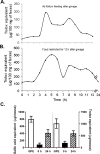Grape polyphenols reduce gut-localized reactive oxygen species associated with the development of metabolic syndrome in mice
- PMID: 30308002
- PMCID: PMC6181265
- DOI: 10.1371/journal.pone.0198716
Grape polyphenols reduce gut-localized reactive oxygen species associated with the development of metabolic syndrome in mice
Abstract
High-fat diet (HFD)-induced leaky gut syndrome combined with low-grade inflammation increase reactive oxygen species (ROS) in the intestine and may contribute to dysbiosis and metabolic syndrome (MetS). Poorly bioavailable and only partially metabolizable dietary polyphenols, such as proanthocyanidins (PACs), may exert their beneficial effects on metabolic health by scavenging intestinal ROS. To test this hypothesis, we developed and validated a novel, noninvasive, in situ method for visualizing intestinal ROS using orally administered ROS-sensitive indocyanine green (ICG) dye. C57BL/6J mice fed HFD for 10 weeks accumulated high levels of intestinal ROS compared to mice fed low-fat diet (LFD). Oral administration of poorly bioavailable grape polyphenol extract (GPE) and β-carotene decreased HFD-induced ROS in the gut to levels comparable to LFD-fed mice, while administration of more bioavailable dietary antioxidants (α-lipoic acid, vitamin C, vitamin E) did not. Forty percent of administered GPE antioxidant activity was measured in feces collected over 24 h, confirming poor bioavailability and persistence in the gut. The bloom of beneficial anaerobic gut bacteria, such as Akkermansia muciniphila, associated with improved metabolic status in rodents and humans may be directly linked to protective antioxidant activity of some dietary components. These findings suggest a possible mechanistic explanation for the beneficial effects of poorly bioavailable polyphenols on metabolic health.
Conflict of interest statement
The authors have declared that no competing interests exist.
Figures





Similar articles
-
Grape proanthocyanidin-induced intestinal bloom of Akkermansia muciniphila is dependent on its baseline abundance and precedes activation of host genes related to metabolic health.J Nutr Biochem. 2018 Jun;56:142-151. doi: 10.1016/j.jnutbio.2018.02.009. Epub 2018 Feb 15. J Nutr Biochem. 2018. PMID: 29571008 Free PMC article.
-
Polyphenol- and Caffeine-Rich Postfermented Pu-erh Tea Improves Diet-Induced Metabolic Syndrome by Remodeling Intestinal Homeostasis in Mice.Infect Immun. 2017 Dec 19;86(1):e00601-17. doi: 10.1128/IAI.00601-17. Print 2018 Jan. Infect Immun. 2017. PMID: 29061705 Free PMC article.
-
Reduced obesity, diabetes, and steatosis upon cinnamon and grape pomace are associated with changes in gut microbiota and markers of gut barrier.Am J Physiol Endocrinol Metab. 2018 Apr 1;314(4):E334-E352. doi: 10.1152/ajpendo.00107.2017. Epub 2017 Sep 5. Am J Physiol Endocrinol Metab. 2018. PMID: 28874357
-
The effects of grape and red wine polyphenols on gut microbiota - A systematic review.Food Res Int. 2018 Nov;113:277-287. doi: 10.1016/j.foodres.2018.07.019. Epub 2018 Jul 11. Food Res Int. 2018. PMID: 30195522
-
Grapes (Vitis vinifera) as a Potential Candidate for the Therapy of the Metabolic Syndrome.Phytother Res. 2016 Apr;30(4):540-56. doi: 10.1002/ptr.5570. Epub 2016 Jan 22. Phytother Res. 2016. PMID: 26800498 Review.
Cited by
-
Chemical Compounds of Berry-Derived Polyphenols and Their Effects on Gut Microbiota, Inflammation, and Cancer.Molecules. 2022 May 20;27(10):3286. doi: 10.3390/molecules27103286. Molecules. 2022. PMID: 35630763 Free PMC article. Review.
-
Elemental iron modifies the redox environment of the gastrointestinal tract: A novel therapeutic target and test for metabolic syndrome.Free Radic Biol Med. 2021 May 20;168:203-213. doi: 10.1016/j.freeradbiomed.2021.03.032. Epub 2021 Apr 5. Free Radic Biol Med. 2021. PMID: 33831549 Free PMC article.
-
A Natural Polyphenol Exerts Antitumor Activity and Circumvents Anti-PD-1 Resistance through Effects on the Gut Microbiota.Cancer Discov. 2022 Apr 1;12(4):1070-1087. doi: 10.1158/2159-8290.CD-21-0808. Cancer Discov. 2022. PMID: 35031549 Free PMC article.
-
Curcumin, Quercetin, Catechins and Metabolic Diseases: The Role of Gut Microbiota.Nutrients. 2021 Jan 12;13(1):206. doi: 10.3390/nu13010206. Nutrients. 2021. PMID: 33445760 Free PMC article. Review.
-
Coix Seed-Based Milk Fermented With Limosilactobacillus reuteri Improves Lipid Metabolism and Gut Microbiota in Mice Fed With a High-Fat Diet.Front Nutr. 2022 Jul 12;9:921255. doi: 10.3389/fnut.2022.921255. eCollection 2022. Front Nutr. 2022. PMID: 35903451 Free PMC article.
References
-
- Guariguata L, Whiting DR, Linnenkamp U, Beagley J, Shaw J. Global Estimates of the Prevalence of Impaired Glucose Tolerance for 2013 and Projections to 2035. Diabetes. 2014;63:A391–A. - PubMed
-
- Tresserra-Rimbau A, Guasch-Ferre M, Salas-Salvado J, Toledo E, Corella D, Castaner O, et al. Intake of Total Polyphenols and Some Classes of Polyphenols Is Inversely Associated with Diabetes in Elderly People at High Cardiovascular Disease Risk. J Nutr. 2016. - PubMed
Publication types
MeSH terms
Substances
Grants and funding
LinkOut - more resources
Full Text Sources
Medical

